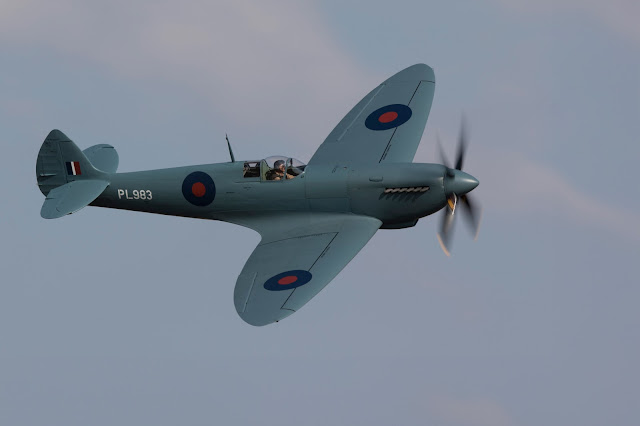 |
Taken in April 1944 above RAF Watnall.
Watnall Hall can be seen bottom right. |
In today's "Tale From Watnall Hall" we discover the surprising back story to this aerial photograph of wartime Watnall taken during an American training mission in 1944. The American photo reconnaissance squadron flew British Spitfires, unarmed and unaccompanied, to Germany taking pictures of enemy locations.
The incredible back story to the photograph and the millions of others taken by the Americans is told on film (link below) in laconic, laid-back style by Lt. Col. John Blyth who is pictured here with his crash-landed aircraft having just come back from a mission to the Ruhr valley dams...
"Spitfire 944 - On 12 September 1944, Lieutenant John Blyth flew into RAF Mount Farm in a 14th Squadron Spitfire PR XI. He had just undertaken a mapping mission over central Germany. Unable to lower his landing gear, Blyth had to make a crash landing. This 2005 film records filmmaker William Lorton interviewing Blyth, who recalls his experiences as a photographic reconnaissance pilot. Blyth is shown viewing footage of his crash landing for the first time. The footage was filmed by Lorton’s great uncle, James Savage, who was serving as a flight surgeon at Mount Farm at the time."
The photo of RAF Watnall in Nottinghamshire has recently been publicly released as part of Historic England's aerial photos collection. It was taken by a US Army Air Force (USAAF) Photographic Reconnaissance unit on 18/4/1944 and shows the local wartime landscape in never before seen detail. Close inspection shows the buildings of RAF Watnall, Watnall Hall with RAF huts in the grounds, the nearby Giltbrook Viaduct and even a train steaming down the Erewash main line near Shipley Boat station with the sun reflecting off the shiny carriage roofs.
The link to the bigger picture is here or here. You can zoom right in to explore the many other interesting details.
 |
American markings on a Spitfire? This is pilot John Blyth's crash-landed Spitfire Mark XI
as used by his American photo reconnaissance squadron based in Oxfordshire. |
 |
Blyth just after his crash landing.
He didn't smoke! |
The film answers a few obvious questions...
Why are Americans flying Spitfires? It was a superior aircraft to the American's existing P-38 Lightings. A supply deal was done over a game of bridge between a US General and his RAF counterpart.
Why were they unarmed? The guns were all replaced with long-range fuel tanks.
What's the Watnall connection? The picture of Watnall was taken on a training mission by the Americans. Their blue-painted, photo reconnaissance version of the Spitfire, which they nicknamed "PRU Blue", will be familiar even to present day Watnall residents. That's because it's an early version of the restored
"Rolls-Royce" Spitfire that was based at Hucknall and was such a familiar sight (and sound) in the summertime Watnall skies before being relocated to East Midlands Airport a few years ago.
 |
| Lt.Col Blyth interviewed aged 83 |
For their clandestine missions into wartime Germany, they were
armed only with cameras, their guns were replaced with extra fuel tanks. They relied on speed and cunning to out fox enemy anti-aircraft guns and fighter patrols. As you can imagine
things did not always go to plan and in this incredible tale from the USAAF squadron, we look at one such occasion which ended in the
crash landing shown above.
Here is Lt. Col Blyth's in his own words telling his amazing tale, well worth 15 mins of your attention... https://vimeo.com/313262760
 |
| The American "PRU Blue" Spitfire so painted to blend into the sky |
The Rolls-Royce SpitfireThe present day Rolls-Royce Spitfire is a fully-restored, blue-painted, photo reconnaissance version of the Spitfire Mark XIX and represents the pinnacle of Spitfire development in terms of speed and high altitude capability. It has a top speed of 446mph and a ceiling of 42,000ft and is powered by the 2,050hp Rolls-Royce Griffon engine. It was bought by Rolls Royce in 1996.
Spitfires in American livery were also to be found in the Eagle squadrons like the one below...
.jpeg) |
| Photo of Spitfire from 4th Fighter Group in 1941. This is EN783, a Spitfire Mk Vb flown by Steve Pisanos of the 334th FS, who previously flew this aircraft under British colours with No 71 "Eagle" Squadron. |
 |
| RAF Photo interpreters |
 |
| No guns, just cameras |
Supermarine Spitfire PR Mk XI PL983
First flying in October 1944, PL983 saw service from 1945 onwards, flying in missions across Europe as part of 4 Squadron until Germany’s surrender. After the war PL983 served as the personal transport of the American Air Attaché, before being flown in the Lympne International Air Race by Lettice Curtis, breaking the 100km closed circuit record. After several civilian owners, PL983 was acquired by the Aircraft Restoration Company and refitted to its wartime specifications and 'PRU Blue' livery.
Supermarine Spitfire PR Mk XI PL965
Flying over 40 reconnaissance sorties in 1945, PL965 flew over German cities, including Berlin, taking images for target maps and damage assessment. Following the Second World War, PL965 was acquired by the Royal Netherlands Air Force, where it was used as an instructional airframe until 1960. After going on display in the Dutch National War and Resistance Museum, PL965 flew again in 1992, and is one of two airworthy Spitfire PR Mk XIs (along with PL983 above).
.png)








.jpeg)


Comments
Post a Comment